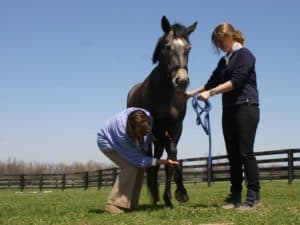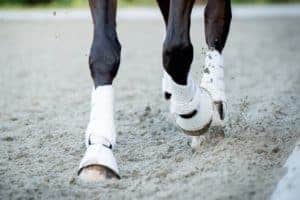
Is My Horse Neurologic or Lame?
Gait-altering conditions such as EPM, wobbler syndrome, and Lyme disease can be tricky to spot and even more difficult to diagnose.

Gait-altering conditions such as EPM, wobbler syndrome, and Lyme disease can be tricky to spot and even more difficult to diagnose.

Do you suspect your horse is lame? Here we’ll show you how to fine-tune your riding senses to recognize lameness when you’re on your horse.

Equine shivers can be a challenging disease to understand, but new study results have revealed important information about it.

Artificial intelligence technology might be able to assist veterinarians in making recommendations to riders about their horse’s performance.

How farriers trim and shoe horses for their unique biomechanics, discipline, and riding surface.

Horses might show a slight asymmetry in their gait without being truly lame.

Researchers found sound horses’ movement didn’t change when traveling on straight, flat surfaces after undergoing foot nerve blocks.

To better understand the piaffe and its effects on a horse’s biomechanics, researchers investigate the ground reaction forces of elite dressage horses performing the movement over pressure plates.

Researchers found horses on regular four- to six-week trim and shoe cycles didn’t have significant gait changes after their hoof care appointments, even on a finely measured level.

What could cause a change in an adult horse’s leg conformation?

Renowned researcher Dr. Hilary Clayton gave a keynote presentation about equine locomotion at the 2019 Equine Science Society Symposium. Here’s our exclusive recap.

Placing a boot on a horse’s weaker leg can use proprioception to help him build muscle force and reverse asymmetry, a study finds.

Colombian Paso Finos have a unique gait most other Paso Finos don’t: the trocha. And recent study results suggest that gait isn’t genetically similar to lateral gaits in other ambling breeds like Icelandics, Tennessee Walking Horses, and pacers.

By analyzing “wither drop,” researchers found that some horses tend to drop their withers lower when bringing one foreleg forward than the other. Here’s what that means for equestrians.

Horse gait analysis is getting more advanced: A recently developed and tested comprehensive motion sensor system can simultaneously record and analyze data remotely from eight parts of a moving horse body, researchers say.

Rising on the “correct” diagonal on a circle or curve helps counterbalance the horse’s movement asymmetry created by the curve itself. And if the horse is lame, the wrong diagonal could enhance that lameness and the right diagonal could mask it.
Stay on top of the most recent Horse Health news with
© 2022 Copyright Statement dolor sit amet, consetetur sadipscing User Terms, sed diam nonumy eirmod tempor invidunt ut labore et dolore magna aliquyam erat, sed diam voluptua. At vero eos et accusam et justo duo dolores et ea rebum. Stet clita kasd gubergren, no sea takimata sanctus est Lorem ipsum dolor sit amet.
"*" indicates required fields